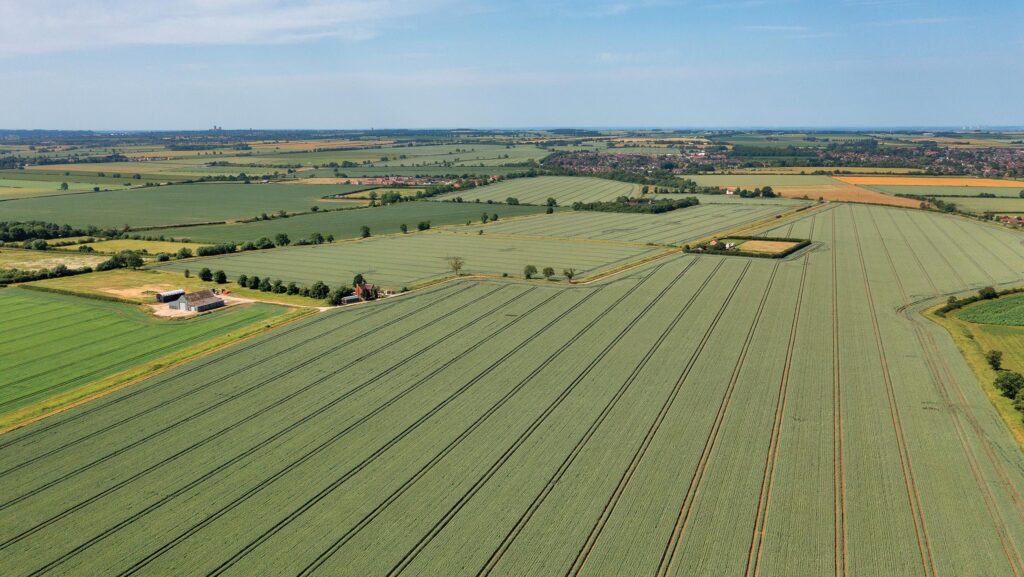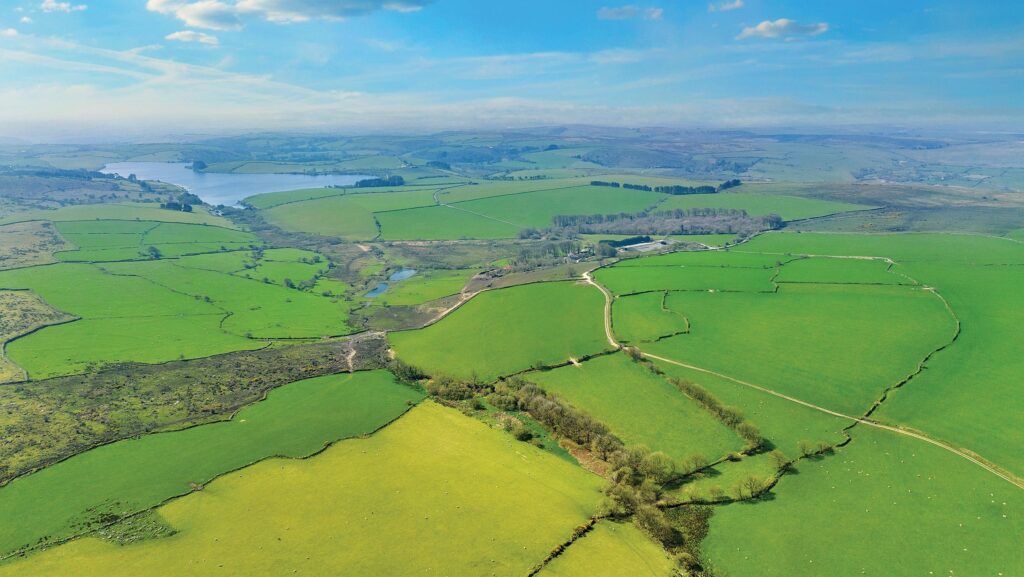What’s behind the rise in farmland sales in 2024
 © BTF Partnership Trueplan
© BTF Partnership Trueplan Agents expect more land to be put on the market this year than last, with high interest rates, a lack of successors and the appalling winter weather all playing a part.
High values are also prompting retirement decisions to be made, in some instances earlier than perhaps envisaged.
Matthew Sudlow, head of estates and farm agency at Strutt & Parker, says: “We predicted that supply would increase in 2024 and there are some early signs that this is happening.
See also: More land market features and advice
“However, the number of farms put up for sale publicly is actually lower than at the same point last year, highlighting that the increase in acreage available is largely down to the launch of a handful of sizeable farms and estates.”
Land market stats
Land agent Strutt & Parker analyses and reports on publicly marketed blocks of 100 acres or larger in England.
The first quarter of the year saw 7,400 acres launched between January and the end of March, which was 6% more than in the same period of 2023, and higher than the five-year average.
More land has also been marketed privately, says the firm.
Prices reached record levels in 2023, it says. However, not enough sales have been concluded in 2024 to give a reliable average for the first quarter of the year.
The average arable price for 2023 was £11,200/acre, which was up 3% on 2022 levels and up 22% over five years.
A record 70% of arable land sold for £10,000/acre or more in 2023, and more than a quarter sold for £12,000/acre or more.
Almost 75% of the farms marketed in 2023 have now sold or are under offer, which is typical for the past five years although lower than in 2021 and 2022.
Farmers Weekly’s Land Tracker monitors the number of acres advertised in the magazine each week, across Great Britain. So far in 2024 it shows a 168% rise compared with 2023, with 14,646 acres advertised.
Savills reports on parcels of more than 50 acres which are openly advertised, and on that basis it puts supply in England at 19,300 acres in the first quarter of 2024.
This was the most land to be marketed during the first quarter of the year since 2008, says the firm, and compares with 13,497 acres in the same months last year.
Across Great Britain it records 24,797 acres marketed in January to March this year, and says the last time more than 20,000 acres was launched in the first quarter was in 2016.
In the first quarter of 2023 a total of 17,244 acres were marketed in Great Britain.
Reasons for sale
The so-called “three D’s” – death, debt and divorce – are cited as the most common reasons that land and farms are put on the market.
“We are seeing that the need to reduce debt, as interest rates have risen, is a factor in some instances,” says Matthew.
“However, we are probably seeing more examples where farmers are choosing to retire because they have no successor or where vendors are motivated by ‘profit-taking’ after a period of sustained growth in values.
“This could be just the market returning to some normality after the Covid-affected years, or a wider trend. Either way, buyers should have a bit more choice than they did 18 months ago.”
That wider choice could put pressure on smaller blocks of land, says Charlie Bryant, a partner at Brown & Co.
The weather and interest rates, among other factors, mean there are more reasons to sell at the moment than there have been for a while, he says.
“There are some serious cashflow problems. There is more land to come onto the market, and perhaps more than we know. But there is still good demand and prices are holding up, which are positives for sellers.”
More smaller blocks to market
He expects more blocks of land to change hands this year, mainly to relieve debt burdens but also sometimes for reinvestment into an alternative enterprise or market.
“It won’t necessarily be large tracts, but I think we will see a lot of 50- to 100-acre blocks and if we start to get a lot more land on the market, there could be pressure on some of those smaller blocks,” he says.
Premium for scale
There is a premium for scale and for well-equipped farms with good infrastructure, especially in the arable sector.
These are in high demand by farmers and investors, many of whom want acres with suitable buildings to support the operation but as little residential value as possible.
Just last week, more than 3,000 acres in England was advertised for sale in Farmers Weekly, including a 1,500-acre arable offering in Lincolnshire through Kent-based agent BTF Partnership.
BTF director Tom French says interest has been strong from buyers with rollover funds to invest and who are looking for uncomplicated propositions.
There is also local farming interest for the land, which has 3,800 tonnes of grain storage and one farmhouse, occupied on a protected tenancy.
Summing up for Knight Frank, partner and head of rural research Andrew Shirley says the market is a little uncertain.
The positives are that there is still lots of rollover cash to be invested. Confirmation of agricultural property relief from inheritance tax being available on environmental schemes has added some confidence.
Uncertainties include the loss of the Basic Payment Scheme now starting to bite, which could boost supply, alongside the possibility that the announcement of a general election date may slow down the market somewhat.
Andrew says: “It’s definitely been a faster start to the year than the past few, and we have a decent pipeline of properties, but think we are still well short of a glut that could really hit confidence.”
Outlook
- More land to come to market in 2024 than last year
- Great variation in values for similar grade arable land depending on location, scale and buyer interest
- Well-equipped arable holdings offering scale are most in demand, for their economies of scale and ability to earn immediately
- Mixed, arable and residential farms are likely to sell more easily than lowland grazing, hill grazing and dairy farms
- More bare land blocks are likely to come to the market
- Marketing activity may slow in advance of the general election
Matt expects premium prices will continue to be paid for prime properties in hotspot areas. “But elsewhere there may be some downward pressure,” he says.
The firm sees a clear split in the market, with mixed, arable and residential farms launched last year more likely to have sold than lowland grazing, hill grazing and dairy holdings.
Savills says average farmland prices have not moved since the final quarter of 2023, with a limited number of transactions to go on, but that there is a huge variation in values even at a very local level.
Alex Lawson, director of the firm’s national farms and estates operation, says the firm has a good mix of farm types in a wide geographical spread to come onto the market later this spring and in summer.
He also emphasised the strong demand for holdings with good infrastructure and scale so that buyers are up and running immediately.
In contrast, where farms need investment to improve things, the time lag before the benefit is a negative for buyers.
He also suggests that more smaller blocks will be offered.
“The private market is still active and I think we will see quite a lot of landowners selling smaller areas of anywhere between 50 and 200 acres on the periphery of farms, perhaps to neighbours and sometimes under the radar.
That might happen for a number of reasons but interest rates and debt would be among those.
“A hundred acres can raise a meaningful amount, and some will be able to do this without severely impacting their remaining farming operation.”
Buying interest
Farmer buyers are still strong contenders, but they face stiff competition from private and institutional investors for the large prime arable units, agents say.
Matt Sudlow handled investment in £50m worth of farmland for private and institutional buyers last year, much of it “off market” and so not publicly advertised.
Natural capital and conservation interests are also clearly in the market where the farm or land ticks the right boxes, depending on land type and location.
Large Cornish farm

Sibleyback Farm © DR Kivell Country Property
One of the largest farms to be sold in the South West for some time has recently completed.
Launched in May last year, Siblyback Farm on the edge of Bodmin Moor in Cornwall has 970 acres of grazing and cutting land in a ring fence.
It was bought by Oxygen Conservation, which owns and manages several sites across England and Scotland and has a mission to address the climate crisis and biodiversity collapse by protecting and restoring natural processes.
Oxygen says Siblyback Farm’s position in one of the UK’s Atlantic rainforest zones means that its climate is sufficiently rainy and mild to allow temperate rainforests to thrive.
Its plans for the farm include launching Cornwall’s largest woodland creation scheme, restoring temperate rainforest and revitalising upland habitats ranging from wet heath and grassland to blanket bog.
The holding has a five-bedroom farmhouse and extensive modern buildings in a secluded setting.
Seven redundant, dilapidated traditional stone barns on the farm have planning consent for conversion to 11 holiday letting units.
Siblyback Farm sold close to its guide price of £10m, through DR Kivell Country Property.
The firm will shortly launch a 300-acre stock and arable farm in south-east Cornwall and a 100-acre stock farm in Devon.
